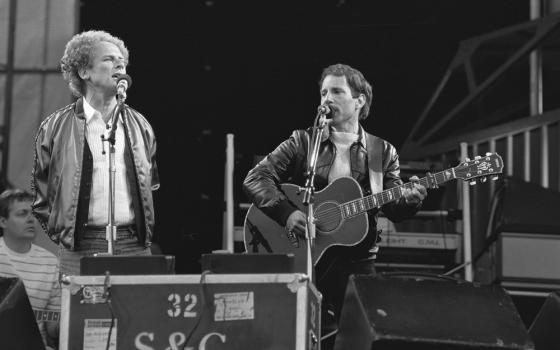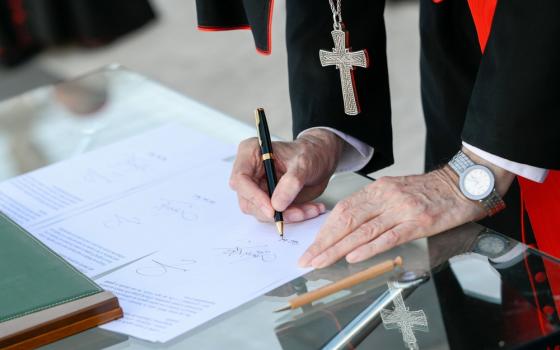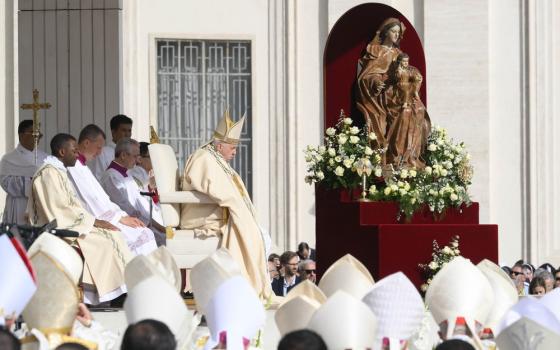Ten years ago Marianist Sr. Leanne Jablonski experienced a “face to face” epiphany about the realities of climate change. She was teaching at Chaminade University of Honolulu, one of her religious community’s schools.
“We already knew the ice was melting,” recalled Jablonski, who holds a doctorate in global climate change and plant physiological ecology from McGill University in Montreal.
One day Yumi, a student from a small Pacific island, told the class that her people were beginning to feel the effects of climate problems. The ocean was rising, and a growing trash buildup was ruining their sustainable fishing business.
“What are you going to do about it?” Yumi challenged her professor. “Move us somewhere else and ship us bottled water?”
“My heart was struck,” said Jablonski, for whom Yumi’s questions still linger, especially the first.
Today, Jablonski has a large platform for searching out such answers. She directs the Marianist Environmental Education Center at Mount Saint John, in Dayton, Ohio, and is an active member of the Cincinnati archdiocese’s climate change task force.
In addition, she is an adjunct professor at the University of Dayton, where she coordinates a freshman program in religious studies and environmental sustainability. The school, which announced in June it would divest from fossil fuels, recently received a $12.5 million grant to expand sustainability education across academic disciplines.
Jablonski’s expertise and connections led the Catholic Climate Covenant to name her as Ohio coordinator for a new public advocacy grassroots effort aimed at teaching Catholics how to promote key church principles on climate and the environment.
Dan Misleh, the Covenant’s executive director, told NCR that the program has offered teleconferences to teach how to generate letters to the editor and op-ed articles regarding climate change and fossil fuels. The primary focus, he said, has been promoting the U.S. Catholic bishops’ support for the U.S. Environmental Protection Agency to create carbon limits for existing power plants, and urging readers to comment before Dec. 1 on EPA’s proposed rules. The Covenant has scheduled about a dozen events this fall educating about the rules at Catholic universities and colleges, including one at Saint Louis University on Sept. 24.
More than 25 people participated in Jablonski’s media trainings last month and an additional 15 asked for additional information. Letters to the editor have appeared in recent weeks in the Cleveland Plain Dealer and the Dayton Daily News.
As part of Jablonski’s Covenant assignment, she is helping Catholics organize events and activities around the organization’s 2014 Feast of St. Francis initiative, which is themed “Creating a Climate of Solidarity: From St. Francis to Pope Francis to You.”
“We are praying for courage and the Spirit’s inspiration in our learning and assessing and advocating – to reduce our use of energy – in our homes and congregations and advocating for public policies that reduce our reliance on fossil fuels," Jablonski said.
So far, at least 20 parishes in the Cincinnati archdiocese have planned Covenant-related activities, with Jablonski working with a number in coordinating St. Francis feast day events. In addition, four conferences highlighting creation care and environmental justice are also planned for later this fall and into the spring at the University of Dayton, Mount St. Joseph University, John Carroll University and Xavier University, she said.
Ohio is one of four states the Catholic Climate Covenant has targeted for this public advocacy endeavor, explained associate director Lonnie Ellis. Through grants from the National Religious Partnership for the Environment, Jablonski and environmental and social justice representatives in Virginia, Pennsylvania and Minnesota are on contract until December.
Why these particular four?
In Virginia and Pennsylvania, Ellis explained the Covenant saw an opportunity to push U.S. senators who have been lukewarm on limiting carbon pollution, but also a region with sea level rise issues on the coast and coal mines further inland.
“They are ripe for the debate,” he said.
As for Ohio, Ellis cited its manufacturing potential for clean energy and a governor, John Kasich, who some feel could be a key voice in its support.
But Ohio’s potential hit a snag in SB 310 -- a bill that freezes the clean renewal energy and energy efficiency standards that the legislature passed in 2008. The bill, signed by Kasich in June, stalls the energy-cleaning efforts of a state filled with fossil fuels.
According to the U.S. Energy Information Administration, Ohio ranks fourth in the nation in carbon emissions -- behind Texas, California and Pennsylvania -- producing 233 million metric tons of carbon (4.5 percent of the U.S. total) in 2011, the most recent year for state-level data. Its carbon levels would rank Ohio in the top-30 emitters among all countries.
“Carbon dioxide knows no borders -- what we emit in Ohio mixes into the planet’s heat-trapping layer,” Jablonski said.
Such a track record leads Jablonski to believe that “we have a moral responsibility to reduce our carbon dioxide emissions,” noting in particular the health risks Ohio’s power plants pose to all, especially the poor and vulnerable.
But Marianist sister also sees a bright side to the Buckeye State in its numerous engineers and entrepreneurs turning their talents to green energy businesses. According to a March 2013 Environmental Entrepreneurs report, Ohio produced nearly 800 clean energy jobs during 2012.
Ellis pointed out that, according to a Solar Foundation report, solar industry jobs in the U.S. grew 20 percent in 2013 and now employs 143,000 people.
“There is so much potential for clean energy jobs,” he said.
While Ellis and others encourage a move from fossil fuels to clean energy, they know the shift is not simple, particularly on those workers and communities that base their livelihoods on the extraction of coal, oil and natural gas.
“These individuals cannot ever be forgotten during the transition away from fossil fuels,” he said, adding that the Catholic church is serious about caring for them.
“We need thoughtful plans to help them and their communities that are affected. Not everyone is going to be able to jump into a clean energy job immediately,” Ellis said.




